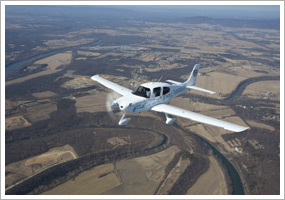| The following stories from the Jan. 7, 2011, edition of AOPA ePilot were provided to AOPA members who expressed an interest in the particular subject areas. Any AOPA member can receive information tailored to their areas of interest by updating their preferences online. |
training tipsWinter flying, ‘hot’ airspace Under what condition, if any, may pilots fly through a restricted area? A) When flying on airways with an ATC clearance. B) With the controlling agency's authorization. C) Regulations do not allow this. Not sure of the answer? It’s better to research the matter during a ground planning session than when airborne. It can be daunting for a student pilot to unfold a sectional aeronautical chart and behold complexes of special-use airspace along a cross-country route. The most common are military operations areas (MOAs). You may know from your ground school studies that there is no prohibition on entering an MOA—although it’s a good idea to get a thorough briefing on whether the area will be “hot” when you get there, as discussed in the “ Training Tip: Operating around MOAs.” Restricted areas are another common type of special-use airspace. But these blocks of airspace may be off limits to general aviation aircraft when active. Times and altitudes of use, and the air traffic control facility (controlling agency) with jurisdiction over restricted airspace are listed on the side panels of your sectional chart. Restricted areas are discussed and a chart depiction illustrated in the Air Safety Institute’s Safety Advisor Airspace for Everyone . The institute’s interactive course Know Before You Go has lots of other great information as well. Here is a definition of restricted airspace from AOPA’s ABCs of Aviation glossary: “Airspace which (when “Active” or “Hot”) usually excludes civilian aircraft. Examples: airspace for rocket flights, practice air-to-air combat or ground-based artillery practice. Temporary restricted areas are established for events such as forest fires, natural disasters or major news stories. Flight through a restricted area may be authorized by the ‘controlling agency’ or by FAA.” Note that a restricted area may not appear on your chart if established temporarily as described above. In any case, be sure to confirm that published information about a restricted area is accurate before a proposed flight. AOPA has long pressed for real-time information being available to pilots about special-use airspace activity. The National Transportation Safety Board shares AOPA’s concerns and has called for improved real-time information being provided. Study the resources given here on “hot” airspace and you will unhesitatingly choose Answer B to the sample question posed above.training products‘The Savvy Flight Instructor’ available for KindleThe Savvy Flight Instructor: Secrets of the Successful CFI is available as an e-book for the Kindle. Written by Flight Training Contributing Editor Greg Brown, The Savvy Flight Instructor teaches tips and strategies for recruiting new and return flight students, increasing students’ skills and customer satisfaction for individual flight instructors as well as for flight schools and managers. Download it for $9.99 from Amazon.
Note: Products listed have not been evaluated by ePilot editors unless otherwise noted. AOPA assumes no responsibility for products or services listed or for claims or actions by manufacturers or vendors. final exam
Question: I recently took a pre-solo written exam. One of the questions was about whether student pilots are required to carry their logbooks during solo flights. I was told it is a requirement; however I have not been able to find a regulation for it. Can you tell me what regulation addresses this issue?
Answer: As a student pilot, you are required to have your logbook with you for all of your solo cross-country flights, but not for every solo flight. According to FAR Part 61.51(i)(2), Presentation of Required Documents, a student pilot must carry the following items in the aircraft on all solo cross-country flights as evidence of the required authorized instructor clearances and endorsements: pilot logbook, student pilot certificate, and “any other record required by this section.” So, if you are just making a few trips around the pattern or perfecting maneuvers in the practice area, there is no requirement to have your logbook with you. For more information on logbooks and logging time, read AOPA’s subject report.
Got a question for our technical services staff? E-mail [email protected] or call the Pilot Information Center, 800/872-2672. Don’t forget the online archive of “Final Exam” questions and answers, searchable by keyword or topic. |
 A sample question from the
A sample question from the 